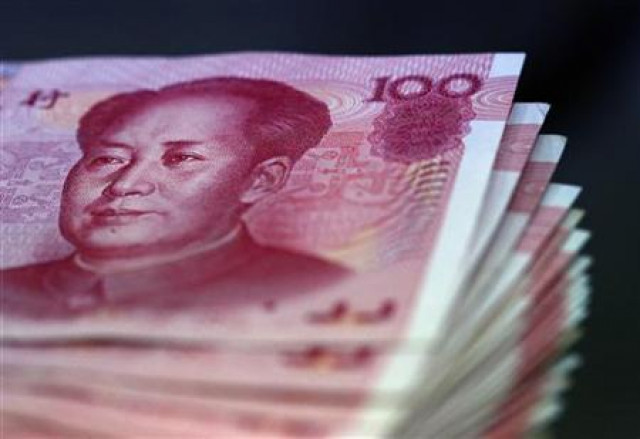
The yuan’s sharp devaluation means that, all else equal, Pakistan’s exports to China will become less competitive, while imports from China will become cheaper. The devaluation, combined with slowdown of the Chinese economy, is likely to exacerbate Pakistan’s trade imbalance with its single largest trading partner.
Exchange rate movements by themselves have a limited impact on competitiveness, which is essentially a function of productivity of the factors of production and technological and managerial efficiency with which the resources are combined. In the absence of productivity and efficiency, currency depreciation or devaluation normally doesn’t significantly shore up exports.
Thus during FY19, the rupee was allowed to shed its value drastically but exports remained stagnant.
However, as in the case of China, if exports are otherwise competitive, the downward movement of the exchange rate can be an effective response to an increase in tariffs (US) or imposition of regulatory duties (Pakistan). Hence, the currency depreciation may hit the bull’s eye for one economy and may come a cropper for another.
In recent years, Pakistan’s massive trade deficit relative to the size of the economy has been a major cause of concern for both the government and businesses.
From $22.16 billion in FY15, the trade deficit went up to $23.9 billion in FY16. The next two years saw the trade imbalance balloon to $32.58 billion and $37.58 billion. In FY19, the trade deficit was brought down to $31.82 billion.
However, the $5.76 billion reduction in the trade deficit was undergirded by the deceleration of economic growth from 5.5% to 3.3% and imposition of regulatory duties, resulting in a $6 billion fall in imports. As a percentage of gross domestic product (GDP), the trade deficit came marginally down from 11.9% in FY18 to 11.2% in FY19.
China has been the principal source of Pakistan’s trade deficit. In FY15, the trade deficit with China was $8.05 billion, which made up 36.31% of Pakistan’s total trade deficit. In FY16, the trade imbalance rose to $10.44 billion or 43.67% of the total trade imbalance.
The following two years saw the trade deficit enhance to $12.67 billion (38.39% of the total deficit) and $14 billion (37.26% of the total deficit). In FY19, the trade deficit with China came down to $10.89 billion, which accounted for 34.22% of the country’s total trade deficit.
Thus, between FY15 and FY18, Pakistan’s trade deficit with China cumulatively increased 74%. During the same period, Pakistan’s overall trade imbalance registered a cumulative growth of 69.58%. Thus, the growth in deficit with China outpaced that in the total deficit. In FY19, the trade deficit with China went down 22.23% while the overall deficit fell 15.32%. This means in both expansion and contraction the trade deficit with China outpaced the overall deficit.
The foregoing makes it abundantly clear that attempts to slash the total trade deficit need to focus on substantially improving the trade balance with China. As always, there are only two ways to reduce the trade imbalance - one is to increase exports while the other is to curtail imports.
Free trade
Since the conclusion of a free trade agreement (FTA) with China - signed in 2006 and became operational in 2007, Pakistan’s imports have gone up at a gallop. As per Pakistan Bureau of Statistics (PBS) data, in 2006-07, the last pre-FTA implementation year, Pakistan’s imports from China were $3.52 billion, which accounted for 11.52% of total global imports of $30.54 billion. At the close of 2017-18, Pakistan’s imports from China had gone up to $15.74 billion, which accounted for 25.89% of total global imports of $60.79 billion. In 2018-19, a contracting pace of economic growth together with trade restrictive measures, such as imposition of regulatory duties, saw a decline in imports from China to $12.70 billion, which made up 23.17% of Pakistan’s total imports of $54.79 billion.
Thus, between 2006-07 and 2017-18, Pakistan’s imports from China increased cumulatively 347%, while during the same period its global imports registered a much weaker cumulative growth of 99%. Not surprisingly, the share of China in Pakistan’s global imports more than doubled.
During FY19, Pakistan’s global imports and those from China contracted 9.8% and 19.31%. Thus, China holds the key to Pakistan’s import growth or contraction.
Tariff concessions
What caused so drastic import growth under the FTA with China? To answer this question, we need to look at the tariff concessions offered to China.
Pakistan gave China concessions on 5,686 tariff lines, of which tariffs were eliminated on 2,423 tariff lines. The concession covered 59% of Pakistan’s imports from China.
Giving such a substantial concession to a much bigger, diversified and much more efficient an economy without preparing the domestic industry to cope with the competition was always a recipe for a massive import influx.
It is argued that implementation of the China-Pakistan Economic Corridor (CPEC) drove up imports heavily from China in the form of machinery and other capital goods. Is it so?
CPEC agreements were signed in April 2015. Therefore, the impact of CPEC on Pakistan’s trade with China began in FY16. In three years, FY16-18, Pakistan’s imports from China increased 30% at 10% per annum from $12.10 billion to $15.74 billion.
In the three years (FY13-15) preceding CPEC, Pakistan’s imports from China had increased 53% at 17.79% per annum from $6.63 billion to $10.17 billion. Thus, it is primarily the enormous difference in productivity and competitiveness, widened by the FTA, between the two countries that underlie Pakistan’s heavy import bill, and by implication the enormous trade deficit with China.
While it imports massively from China, Pakistan’s exports to China are only $1.86 billion. Generally, two reasons are given for Pakistan’s inability to take advantage of the FTA and thus a highly skewed bilateral trade.
One, although Pakistan received concessions on 6,418 tariff lines under the FTA, these tariff lines covered only 5% of China’s imports from Pakistan. Thus, in effect Pakistan was given a meagre market access by China.
Two, the products of Pakistan’s export interest suffered preference erosion in the wake of China’s FTA with Asean member countries. The tariff faced by Pakistan’s rice was 65% while the average tariff for home textiles, knitted garments and woven garments was 4%, 7% and 9% respectively.
On the other hand, Asean countries received duty-free market access in China for home textiles, knitted garments and woven garments, while for rice the applied Chinese tariff was 35%.
This obviously placed Pakistan’s star products in a relatively disadvantageous position in the Chinese market. In the second phase of the Pakistan-China FTA, which is likely to kick-start soon, Pakistan has been given market access for these products at an even kneel with Asean.
The increased market access in the second phase of the FTA is important but given Pakistan’s severe productivity constraints viz-a-viz its competitors in the Chinese market, it may not be sufficient to rack up exports. In fact, such constraints should have been addressed before going into the second phase of the FTA.
Moreover, since the FTA is not a free lunch, China will also get enhanced market access and being more productive and efficient than Pakistan head and shoulder, it is likely to remain the bigger beneficiary. The yuan’s devaluation will, for sure, give a leg-up to the Chinese competitiveness.
The writer is an Islamabad-based columnist
Published in The Express Tribune, Septembert 2nd, 2019.
Like Business on Facebook, follow @TribuneBiz on Twitter to stay informed and join in the conversation.


















COMMENTS
Comments are moderated and generally will be posted if they are on-topic and not abusive.
For more information, please see our Comments FAQ